Python

Ants and Bees using CNN
We are trying to build a model using CNN with the help of PyTorch library that can differentiate between images of Ants and Bees.
Data used in this task is available at : https://www.kaggle.com/watanabe2362/hymenoptera
This process is divided into two parts:
- Part I : Building the model and saving it.
- Part II: Loading the model and using it.
Part I:
Importing necessary libraries
import torchvision
import torch.nn as nn
import torch
import torch.nn.functional as F
from torchvision import transforms,models,datasets
import matplotlib.pyplot as plt
from PIL import Image
import numpy as np
from torch import optim
#connecting python script to gpu
device = 'cuda' if torch.cuda.is_available() else 'cpu'
import cv2, glob, numpy as np, pandas as pd
import matplotlib.pyplot as plt
%matplotlib inline
from glob import glob
!pip install torchsummaryLoad Data
train_data_dir = '.../Data/hymenoptera_data/train'
val_data_dir = '.../Data/hymenoptera_data/val'
Making a class which will help to load and label data
from torch.utils.data import DataLoader, Dataset
class ants_bees(Dataset):
def __init__(self, folder):
ants = glob(folder+'/ants/*.jpg')
bees = glob(folder+'/bees/*.jpg')
self.fpaths = ants + bees
from random import shuffle, seed; seed(10); shuffle(self.fpaths)
self.targets = [fpath.split('/')[-2].startswith('bees') for fpath in self.fpaths] # ants=0 & bees=1
def __len__(self): return len(self.fpaths)
def __getitem__(self, ix):
f = self.fpaths[ix]
target = self.targets[ix]
im = (cv2.imread(f)[:,:,::-1])
im = cv2.resize(im, (224,224))
return torch.tensor(im/255).permute(2,0,1).to(device).float(), torch.tensor([target]).float().to(device)Checking and Visualizing Data
data = ants_bees(train_data_dir)
im, label = data[220]
plt.imshow(im.permute(1,2,0).cpu())
print(label)
len(data)
Defining Neural Network Layers
#Defining convolution layer
def conv_layer(ni,no,kernel_size,stride=1):
return nn.Sequential(
nn.Conv2d(ni, no, kernel_size, stride),
nn.ReLU(),
nn.BatchNorm2d(no),
nn.MaxPool2d(2)
)
#Defining deep CNN model
def get_model():
model = nn.Sequential(
conv_layer(3, 64, 3),
conv_layer(64, 512, 3),
conv_layer(512, 512, 3),
conv_layer(512, 512, 3),
conv_layer(512, 512, 3),
conv_layer(512, 512, 3),
nn.Flatten(),
nn.Linear(512, 1),
nn.Sigmoid(),
).to(device)
#Binary cross entropy is used to calculate loss
loss_fn = nn.BCELoss()
#Adam us used as an optimizer
optimizer = torch.optim.Adam(model.parameters(), lr= 1e-3)
return model, loss_fn, optimizerSummary of the Model
#Printing summary of model
from torchsummary import summary
model, loss_fn, optimizer = get_model()
summary(model, input_size=(3, 224, 224))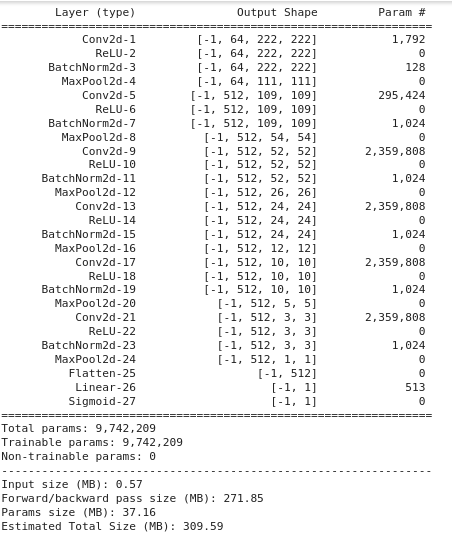
Defining functions for loading training and accuracy
def train_batch(x, y, model, opt, loss_fn):
prediction = model(x)
batch_loss = loss_fn(prediction, y)
batch_loss.backward()
optimizer.step()
optimizer.zero_grad()
return batch_loss.item()
@torch.no_grad()
def accuracy(x, y, model):
prediction = model(x)
is_correct = (prediction > 0.5) == y
return is_correct.cpu().numpy().tolist()Functions to load data and to calculate validation loss
def get_data():
train = ants_bees(train_data_dir)
trn_dl = DataLoader(train, batch_size=32, shuffle=True, drop_last = True)
val = ants_bees(val_data_dir)
val_dl = DataLoader(val, batch_size=32, shuffle=True, drop_last = True)
return trn_dl, val_dl
@torch.no_grad()
def val_loss(x, y, model):
prediction = model(x)
val_loss = loss_fn(prediction, y)
return val_loss.item()Loading Data and model along with its parameters
trn_dl, val_dl = get_data()
model, loss_fn, optimizer = get_model()Training for 10 epochs; Calculation train accuracy, validation accuracy, train loss and validation loss
train_losses, train_accuracies = [], []
val_losses, val_accuracies = [], []
for epoch in range(10):
print(epoch)
train_epoch_losses, train_epoch_accuracies = [], []
val_epoch_accuracies = []
for ix, batch in enumerate(iter(trn_dl)):
#print(ix)
x, y = batch
batch_loss = train_batch(x, y, model, optimizer, loss_fn)
#print(y)
train_epoch_losses.append(batch_loss)
train_epoch_loss = np.array(train_epoch_losses).mean()
for ix, batch in enumerate(iter(trn_dl)):
x, y = batch
is_correct = accuracy(x, y, model)
train_epoch_accuracies.extend(is_correct)
train_epoch_accuracy = np.mean(train_epoch_accuracies)
for ix, batch in enumerate(iter(val_dl)):
x, y = batch
val_is_correct = accuracy(x, y, model)
val_epoch_accuracies.extend(val_is_correct)
validation_loss = val_loss(x, y, model)
val_epoch_accuracy = np.mean(val_epoch_accuracies)
train_losses.append(train_epoch_loss)
train_accuracies.append(train_epoch_accuracy)
val_losses.append(validation_loss)
val_accuracies.append(val_epoch_accuracy)Loss and Accuracy after training for 10 epochs
print(f'Training loss after 10 epochs: {train_epoch_loss}\n')
print(f'Validation loss after 10 epochs: {validation_loss}\n')
print(f'Training accuracy after 10 epochs: {train_epoch_accuracy*100}\n')
print(f'Validation accuracy after 10 epochs: {val_epoch_accuracy*100}\n')
Plotting graph of accuracy and losses
epochs = np.arange(10)+1
import matplotlib.ticker as mtick
import matplotlib.pyplot as plt
import matplotlib.ticker as mticker
%matplotlib inline
plt.rcParams["figure.figsize"] = (10,5)
plt.subplot(211)
plt.plot(epochs, train_losses, 'bo', label='Training loss')
plt.plot(epochs, val_losses, 'r', label='Validation loss')
plt.gca().xaxis.set_major_locator(mticker.MultipleLocator(1))
plt.title('Training and validation loss with CNN')
plt.xlabel('Epochs')
plt.ylabel('Loss')
plt.legend()
plt.grid('off')
plt.show()
plt.subplot(212)
plt.plot(epochs, train_accuracies, 'bo', label='Training accuracy')
plt.plot(epochs, val_accuracies, 'r', label='Validation accuracy')
plt.gca().xaxis.set_major_locator(mticker.MultipleLocator(1))
plt.title('Training and validation accuracy with CNN')
plt.xlabel('Epochs')
plt.ylabel('Accuracy')
plt.gca().set_yticklabels(['{:.0f}%'.format(x*100) for x in plt.gca().get_yticks()])
plt.legend()
plt.grid('off')
plt.show()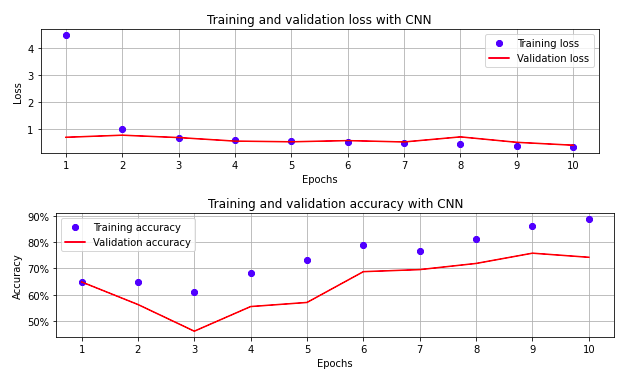
Save Model
#save model
model_scripted = torch.jit.script(model) # Export to TorchScript
model_scripted.save('.../ants_bees_model_epoch_10_scripted.pt') Part II: Loading model and using it
Importing Files
import torch
device = 'cuda' if torch.cuda.is_available() else 'cpu'
import cv2, glob, numpy as np, pandas as pd
import matplotlib.pyplot as plt
%matplotlib inline
from glob import glob
from google.colab import filesimport warnings
warnings.filterwarnings('ignore')Loading model
model = torch.jit.load('.../ants_bees_model_epoch_10_scripted.pt')
model.eval()Define Function which takes image as an input and predicts whether its an ant or a bee
def predict(img_file):
im = (cv2.imread(file_name)[:,:,::-1])
im = cv2.resize(im, (224,224))
im = torch.tensor(im/255).permute(2,0,1).to(device).float()
img = im
img = img.view(3,224, 224)
img2 = torch.tensor(img).to(device).float()
img3 = torch.tensor(img2).view(-1,3,224,224)
np_output = model(img3).cpu().detach().numpy()
print(np_output)
if((np.round(np_output[0][0],decimals=0))==1):
prediction = 'This is a bee'
else:
prediction = 'This is an ant'
plt.imshow(im.permute(1,2,0).cpu())
return prediction
Loading The image
uploaded = files.upload()
file_name = uploaded.keys()
file_name = list(file_name)[0]
predict(file_name)Final Output
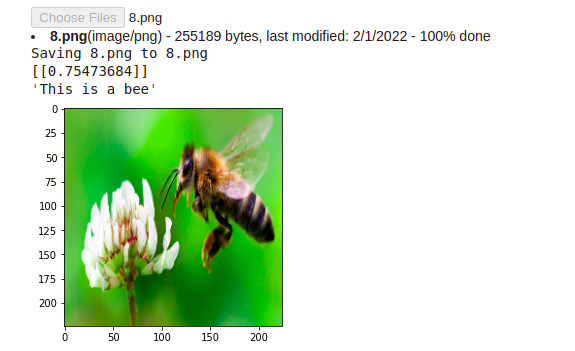
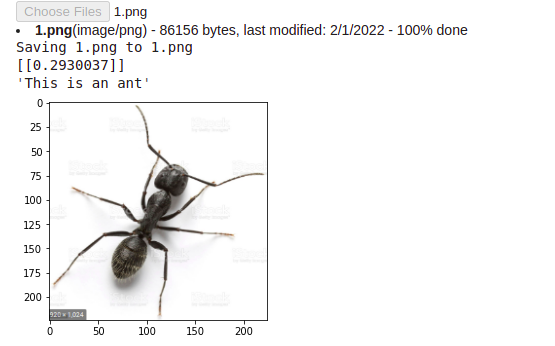
When model got it wrong
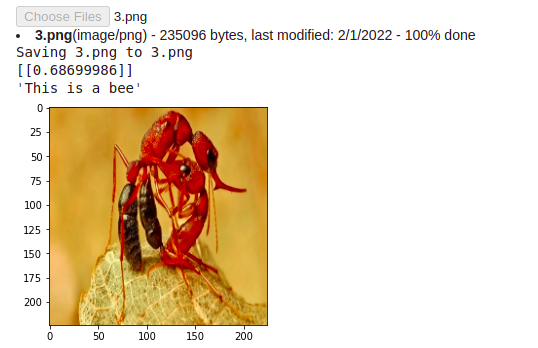
pontu
0